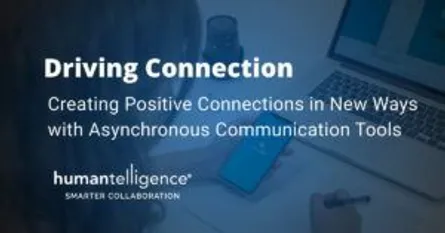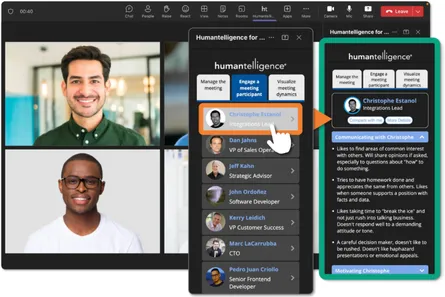
The Power of Connection at Work
- Admin
- Collaboration
- 30 Aug, 2023

The way we work has changed. Distributed teams along with generational differences and diverse personalities make collaboration, communication, and connection at work more difficult than ever. Miscommunications that could be easily rectified with a quick face-to-face chat now are left to fester at our keyboards. At the same time, the world of flexible remote and hybrid work has opened up many opportunities for employees around the world.
Unfortunately, some of those opportunities lead to other companies.
That doesn’t mean remote work isn’t working. It just means we need to do a better job of encouraging interpersonal connection at work. In this article, see how you can harness the awesome power of human connection to improve employee engagement and increase retention.
The High Cost of Losing Connection at Work
The sudden shift to remote work over the past couple of years gave our people an opportunity to do more than just spruce up their home offices – it also gave them a chance to think and reevaluate bigger topics, like just how work fits into their lives.
And this has undoubtedly contributed to trends like the Great Resignation and quiet quitting, as many employees realized that personal needs, such as connection, family, happiness, and health mattered more to them than promotions, career paths, and other work-related objectives. In fact, according to Gallup, U.S. employee engagement took a giant step backward during the second quarter of 2022, with the proportion of engaged workers remaining at 32 percent while the proportion of actively disengaged increasing to 18 percent. This put the ratio of engaged to actively disengaged employees at 1.8 to 1, the lowest in almost a decade.
We don’t have to tell you, this turnover can leave your organization in a bind. Estimates show that every time a business replaces a salaried employee, it costs 6 to 9 months’ salary on average. For a manager making $60,000 a year, that’s $30,000 to $45,000 in recruiting and training expenses. This doesn’t even account for all of the soft costs required to onboard a new employee, the impacts on morale and culture, loss of knowledge and productivity, or the ways that whole teams can be affected when it’s a team leader who leaves.
Not to scare you further, but research out of LinkedIn also shows that 70 percent of the global workforce is passive talent, and more than half would consider leaving for the right opportunity. So basically, everyone is a flight risk!
The good news is that one of the most important and impactful solutions takes into account the fact that work life and personal contentment aren’t mutually exclusive. In fact, everything – including employee engagement and retention – improves when we bring the two into alignment through deeper connection.
The Importance of Connection at Work
Connection at work matters. Would you be surprised to learn that people with friendly connections at work perform better in their job? According to research, people who have a good friend at work are not only more likely to be happier and healthier, but they are also seven times as likely to be engaged in their job. In addition, employees who report having friends at work have higher levels of productivity, retention and job satisfaction than those who don’t.
The feelings of belonging and purpose that friendship and connection foster are among the top benefits people are looking to get from their work. These feelings are so profound and powerful that some employees would even trade some compensation for more meaningful relationships – at least that’s what over half of the employees surveyed by BetterUp Labs found.
Feeling more connected at work doesn’t only make employees happier. It has several other clear effects on employee and organizational performance. For example, 94 percent of employees agreed that they’re more productive when they feel connected to their colleagues, and, when compared to employees who didn’t feel actively connected to their workplace, connected employees were:
- More than 3 in 5 employees with high social connectivity report being highly engaged, whereas just over 1 in 10 employees with low social connectivity consider themselves highly engaged at work.
- Employees who have strong social bonds with their coworkers are more motivated to perform.
- Individuals who report having connection at work are 7x more likely to exhibit better engagement, customer relations, work quality, and wellbeing, as well as a lower risk of injury.
- Highly engaged teams show 21% greater profitability.
Employee engagement consists of concrete behavior, not an abstract feeling. Organizations that view engagement as a feeling often conduct employee surveys and provide offer perks to improve the results. Gallup reports that the most successful organizations make employee engagement central to their business strategy. They give employees clear expectations and provide them with the tools and support to do their best work.
Why are engaged teams more profitable? Those teams who score in the top 20 percent in engagement realize a 41 percent reduction in absenteeism, and 59 percent less turnover. Engaged employees show up with passion, purpose, presence, and energy.
So, let’s turn our focus toward increasing connection – and that doesn’t mean forcing everyone back into the office.
Return-to-Office Doesn’t Always Make for Better Connection
A recent study from Accenture found that on-site workers were the most likely to say they felt disconnected at work. The study challenges the assumption that working only on-site makes people feel more connected. People who work on-site, in comparison with those who work in hybrid or remote workplaces, feel the least connected of the three groups studied — 42 percent of on-site workers say they feel “not connected” versus 36 percent hybrid and 22 percent fully remote.
While in-person time is vital, physical proximity that lacks leadership support, flexibility, technology or sense of purpose doesn’t necessarily translate into people feeling deeper connections to their work and to each other.
It’s not about the building, the site, the campus. As with most things in this life, it’s about what’s going on inside that counts.
Accenture’s Organizational culture: From always connected to omni-connected report outlines how companies can strengthen culture and connection by delivering what they refer to as “omni-connected experiences,” which level the playing field, enabling people to participate fully and have an equitable experience — growing their careers, building relationships, and creating both personal and business value and impact — regardless of where they physically work.
In Enboarder’s research of building connection at work, survey findings showed that the things that made the biggest impact on employees’ feelings of connectedness, and hence, their retention rates were things you’re probably already doing: team meetings (49%), skills sharing with coworkers and peers (29%), spontaneous interactions with colleagues (28%), and all-company meetings (26%).
Now What?
Just because you’re already doing it doesn’t mean it’s working well. Consider optimizing these efforts and employing technology that supports them.
The key to deeper connection and strong engagement is to simply enable and activate the everyday interactions between coworkers.
- Make sure your employees are making the most of their in-office days and that there are adequate spaces and reasons for in-person interactions.
- Encourage spontaneous check-ins. With fewer people around us, it’s easy just to immerse ourselves in work, but regular check-ins with others are crucial for everyone, in particular leaders who may not otherwise notice if their team is struggling.
- Make sure your remote employees aren’t being overlooked for team and company events. Be mindful to create opportunities for genuine human connection.
- Support informal mentorships. Facilitate communication across departments and employees of different ages and experience levels so team members can learn more about each other and their areas of work, while sparking new ideas and interests.
If anything good came out of our rapid, pandemic-induced shift to remote work, it was that we finally had the unique opportunity to meet many of our colleagues’ families and pets over Zoom. This helped us see them as the human beings they are, which fueled a sense of connection when we needed it most. Now, we have the opportunity to take that sense of connection and amplify it.
Remember, increasing employee retention doesn’t just help your company; it helps your people. An employee who feels connection at work, is an employee who can engage fully. And an employee who can fully engage is an employee who feels compelled to stay. Need help getting your employees connected and on the same page, talk to one of our solutions experts!


























-Low-Quality.DNBpXyLx_1VXSiM.webp)
.CiqwvMOO_A63sY.webp)




-Medium-Quality.ZFp5mEuF_Z13ebXJ.webp)




